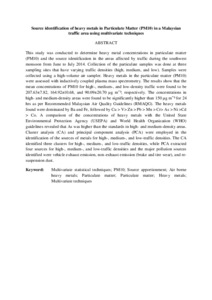Citation
Elhadi, Rasheida E. and Abdullah, Ahmad Makmom and Abdullah, Abdul Halim and Ash’aari, Zulfa Hanan and Kura, Nura Umar and D. Y., Gumel and Adamu, Abdullahi
(2017)
Source identification of heavy metals in Particulate Matter (PM10) in a Malaysian traffic area using multivariate techniques.
Polish Journal of Environmental Studies, 26 (6).
2523 - 2532.
ISSN 1230-1485
Abstract
This study was conducted to determine heavy metal concentrations in particulate matter (PM10) and the source identification in the areas affected by traffic during the southwest monsoon from June to July 2014. Collection of the particulate samples was done at three sampling sites that have varying traffic densities (high, medium, and low). Samples were collected using a high-volume air sampler. Heavy metals in the particulate matter (PM10) were assessed with inductively coupled plasma mass spectrometry. The results show that the mean concentrations of PM10 for high-, medium-, and low-density traffic were found to be 207.63±7.82, 164.92±10.68, and 90.09±20.70 µg m⁻³, respectively. The concentrations in high- and medium-density areas were found to be significantly higher than 150 µg m⁻³ for 24 hrs as per Recommended Malaysian Air Quality Guidelines (RMAQG). The heavy metals found were dominated by Ba and Fe, followed by Cu > V> Zn > Pb > Mn > Cr> As > Ni >Cd > Co. A comparison of the concentrations of heavy metals with the United State Environmental Protection Agency (USEPA) and World Health Organization (WHO) guidelines revealed that As was higher than the standards in high- and medium-density areas. Cluster analysis (CA) and principal component analysis (PCA) were employed in the identification of the sources of metals for high-, medium-, and low-traffic densities. The CA identified three clusters for high-, medium-, and low-traffic densities, while PCA extracted four sources for high-, medium-, and low-traffic densities and the major pollution sources identified were vehicle exhaust emission, non-exhaust emission (brake and tire wear), and re-suspension dust.
Download File
![[img]](http://psasir.upm.edu.my/63266/1.hassmallThumbnailVersion/Source%20identification%20of%20heavy%20metals%20in%20Particulate%20Matter%20%28PM10%29%20in%20a%20Malaysian%20traffic%20area%20using%20multivariate%20techniques.pdf)  Preview |
|
Text (Abstract)
Source identification of heavy metals in Particulate Matter (PM10) in a Malaysian traffic area using multivariate techniques.pdf
Download (116kB)
| Preview
|
|
Additional Metadata
Actions (login required)
 |
View Item |

